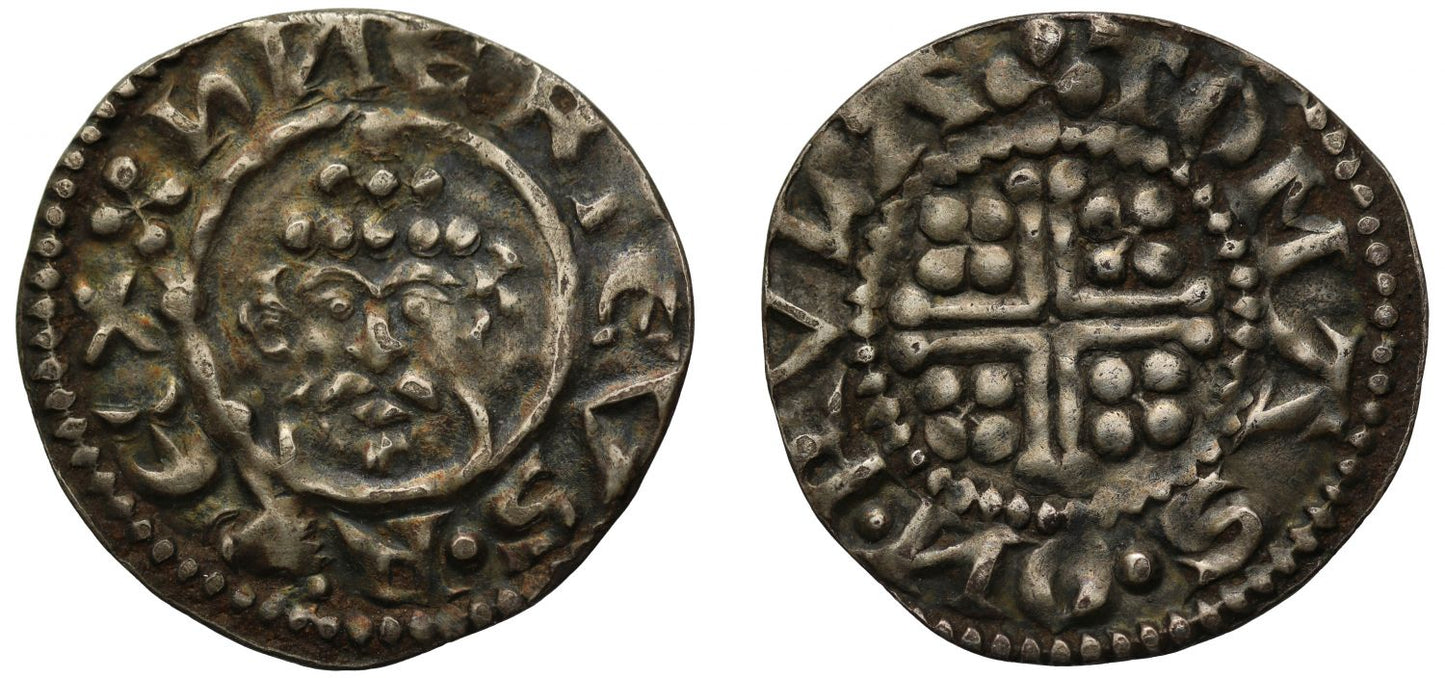FAQs
What makes a coin valuable?
I have coins to sell, what’s the next step?
How will my purchases be shipped?
What happens if I’m not entirely happy with my purchase?
John Penny, Rhuddlan Mint Wales, moneyer Tomas
John (1199-1216), silver Penny, short cross type, in the name of his Father, Rhuddlan Mint Wales (1190-1215), group I class ii, moneyer Tomas, facing crowned head with linear collar, hand holding sceptre at left, legend with inner linear and outer beaded border surrounding, commences upper left, hNERICVS. R EX, note error in spelling, the N retrograde, rev. short voided cross pommée, small cross pommée in each angle, initial mark trefoil of pellets, legend surrounding with inner and outer beaded border, +TOMAS. ON. RVLA, the N retrograde, weight 1.19g (Mass 2175; N.972/2; S.p.167). Once lightly cleaned, now toned and well struck for this distinctive localised issue, good very fine and rare.
All of the English coins dating to the reign of King John by class, are depicted in the name of his Father King Henry II as are those of Richard I who preceded him. The legend therefore reads "Henry King" on the obverse and "Thomas of Rhuddlan" on the reverse.
The younger brother of Richard the Lionheart and at time estranged, John was pronounced heir to England on 11th March 1194, he being the youngest son of Henry II born on 24th December 1166 and at first nicknamed Lackland on the assumption he would never inherit much land. In contrast to this name and as Henry II's favourite son, John had been appointed Lord of Ireland in 1177 by the age of ten and given lands in England and on the Continent and later proclaimed King on Richard's death in 1199. John married twice but had multiple mistresses and illegitimate children. First he married Isabella Countess of Gloucester from 1189-99 ending in annulment, then Isabella Countess of Angouleme who was no older than 15 upon their marriage in 1200 who bore home five children from 1207-1215.
John called a conference of moneyers in 1205 which reformed the administration of the coinage and class 5 short cross pennies are thought to coincide with the results from this meeting, though the coins continue to be still in the name of his Father Henry.
Otherwise during this reign, King Philip II of France agreed to recognise John's possession of Angevin lands at the peace Treaty of Le Goulet in 1200. War again broke out with France in 1202 and though John achieved early victories but later due to shortages of supplies and because of his treatment of his Nobles in that area the empire in northern France collapsed by 1204. He tried to regain these lands for the next decade, was excommunicated after an argument by Pope Innocent III in 1209 not resolved until 1213, and eventually suffered defeat by Philip at the Battle of Bouvines in 1214. Upon return to England he faced rebellion from multiple nobles and barons leading to the Magna Carta peace treaty of 1215, from which neither side really complied leaving to more civil unrest and a stalemate. John died of dysentery in 1216 after campaigning in the east of England and famously losing much of his baggage train and treasure in the flooding marshes and quick sands of the Wash in East Anglia, he died within a week or two of this happening by the 19th October 1216 with his body carried south for interment at Worcester Cathedral. In the aftermath his nine year old son was proclaimed King Henry III under the protector-ship of William Marshall who resuscitated the terms of the Magna Carta in edited form from 1217 as the basis for government in the future.
All of the coins dating to the reign of John by class, are depicted in the name of his Father King Henry II as are those of King Richard I who preceded him. The Rhuddlan Mint in Wales operates throughout the reigns of Henry II to John but does not follow the established classes of the other coinages of the Kingdom having its own style which is split into two groups with Tomas operating only in group one along with Halli and Simond, the latter being the only moneyer to cross into group II with a new moneyer Henricus. It is thought they were issued under the authority of the Welsh Princes of Gwynned. We note the Mass Collection coin of this variety was pierced.
Provenance:
Ex Spink Numismatic Circular, April 2003, HS1210.
Ex Neil and Gina Smith Collection, The New York Sale XLIX, 15th January 2020, lot 1238, hammer $1,500
Ex Collection of an English Doctor part III, Sovereign Rarities fixed price list online August 2022.
FAQs
What makes a coin valuable?
I have coins to sell, what’s the next step?
How will my purchases be shipped?
What happens if I’m not entirely happy with my purchase?













